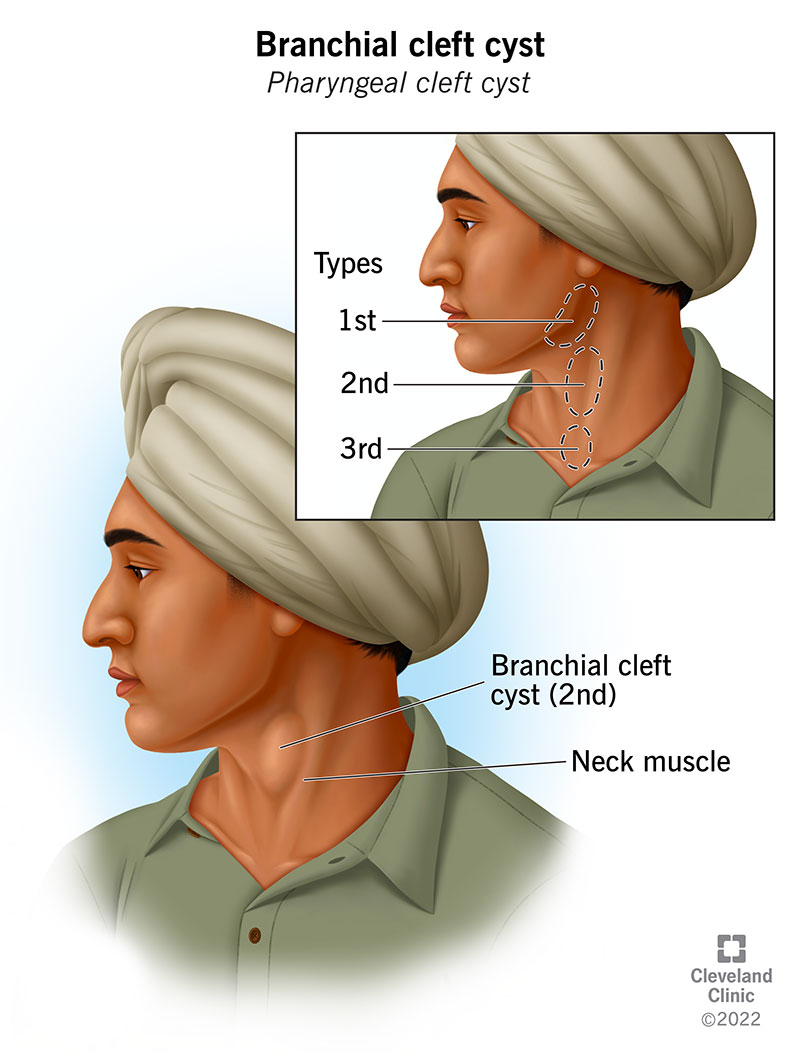A branchial cleft cyst is a type of neck mass some people are born with. These cysts can appear at any age, but they’re most common in children. Branchial cysts are almost always noncancerous. But they can cause symptoms if they get infected or press on nearby nerves or blood vessels. Surgical cyst removal can address these issues.
Advertisement
Cleveland Clinic is a non-profit academic medical center. Advertising on our site helps support our mission. We do not endorse non-Cleveland Clinic products or services. Policy

Branchial cleft cysts are small, fluid-filled sacs that appear under your skin on one or both sides of your neck. You can usually see them somewhere between your jaw and collarbone. Healthcare providers may refer to branchial cleft cysts as pharyngeal cleft cysts or as a type of neck mass.
Advertisement
Cleveland Clinic is a non-profit academic medical center. Advertising on our site helps support our mission. We do not endorse non-Cleveland Clinic products or services. Policy
These cysts are congenital, meaning you’re born with them. It’s possible to have a branchial cyst for many years and not know it. Some people only realize they have a cyst if it gets infected.
Branchial cleft cysts are typically benign (noncancerous). In very rare instances, these cysts can turn into cancer. Even if the branchial cyst doesn’t cause issues, you might need surgery to remove it and prevent future infections.
Healthcare providers categorize branchial cleft cysts according to where they develop:
Branchial cleft cysts are one of the most common types of neck masses, especially in children. Overall, it’s hard to know exactly how many people have branchial cysts because they don’t always cause symptoms.
Advertisement
Sometimes, branchial cleft cysts don’t cause symptoms. It’s possible to have one and not know it.
If you do develop branchial cleft cyst symptoms, they could include:
If you have an infected branchial cleft cyst, you might have:
Unexpected changes during fetal development cause branchial cleft cysts. Tissues around the fetus’s neck and collarbone area don’t form correctly. When this happens, it creates empty spaces. Fluid fills these empty spaces, causing cysts to form.
Untreated branchial cysts can cause several complications like:
Healthcare providers will examine your neck and ask about your symptoms. They might need to take imaging tests like:
If you have a first branchial cleft cyst, your healthcare provider may also do a hearing test. That’s because these cysts form near your ear and may affect nearby structures.
Branchial cleft cyst treatment depends on the type of cyst, its location and whether it’s infected. Options include:
Like any surgical procedure, removing a branchial cleft cyst comes with some risk. Possible complications include:
Your healthcare provider can help you weigh the risks and benefits of surgery. Talk to them if you have questions about your treatment plan.
If you have a branchial cleft cyst that doesn’t cause problems, you might not need to do anything. But if it gets infected, you’ll need antibiotics. If the infection keeps returning, your healthcare provider might recommend surgery to remove it. Very few branchial cysts recur (come back) after surgery.
The outlook is good. Most people who have cyst removal surgery recover with good results and no complications.
You can’t prevent branchial cleft cysts because they form during fetal development. There’s no way to keep them from occurring. If your baby was born with a branchial cyst, it’s not because of something you did or didn’t do. It’s just something that happens.
Advertisement
If you’ve had surgery to remove a branchial cleft cyst, let your healthcare provider know if you develop:
If you or your child has branchial cleft cysts, here are some questions you might want to ask your healthcare provider:
It’s unnerving to find a lump on your neck, even if the lump doesn’t hurt. Many times, mysterious lumps turn out to be cysts. Branchial cleft cysts are almost always noncancerous. If you have one that causes problems, your healthcare provider can remove it with surgery. If you notice something that doesn’t seem quite right, let your healthcare provider know. They can determine the cause and recommend appropriate treatment.
Advertisement
Any lump on your child’s neck can cause you to worry. But branchial cleft cysts are benign. And Cleveland Clinic Children’s experts are here to help.

Last reviewed on 10/23/2024.
Learn more about the Health Library and our editorial process.